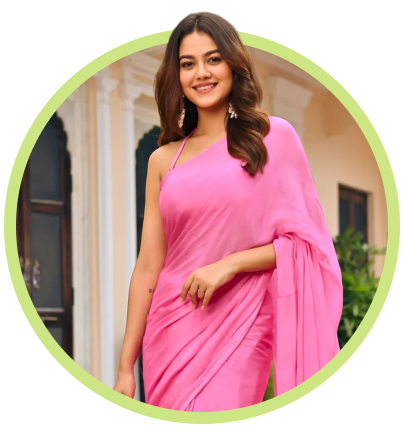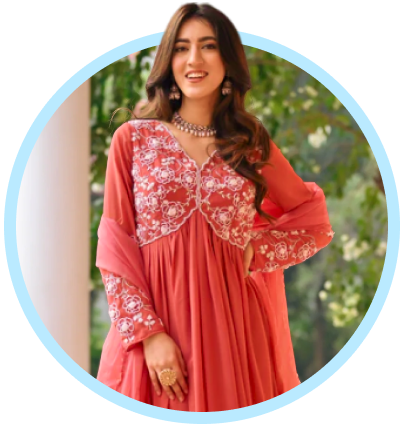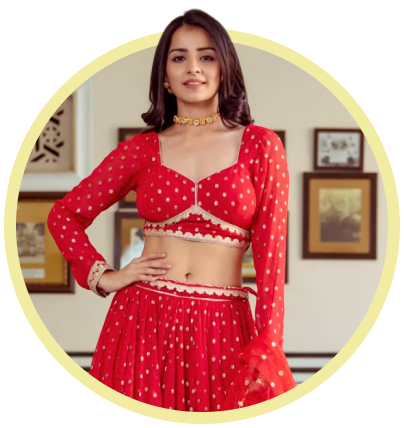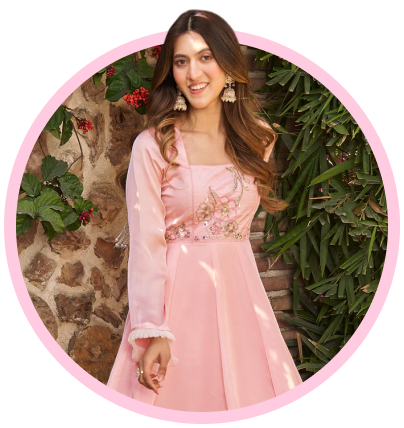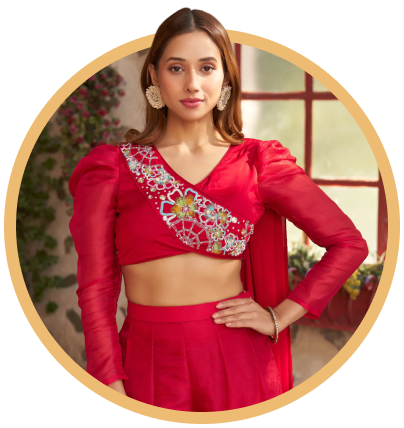Lehengas and sarees are widely used as bridal attire for special occasions. We have observed that most Indian brides wear lehengas, but brides from some regions of India wear sarees. On their D-Day, anyone can
wear a wedding saree or a lehenga; the choice is theirs. Sarees are the ideal bridal attire for Bengali and South Indian brides. Choosing THE bridal dress on your wedding day is a real challenge! And this is the most crucial issue that requires the most prolonged resolution. Finding the ideal bridal attire is essential but sometimes extremely difficult. Understand that you are not bound to wear a particular outfit for your special day and are entitled to pick what resonates the most with you; after all, it's your day!
Saree Or Lehenga: Which Is the Most Popular for Weddings?
1. Lehenga
A lehenga is worn for various pre-wedding events in addition to the wedding. Different lehenga designs, colors, and themes are kept in mind depending on the occasion. You can select from multiple variations of this dress for your BIG day. Some of them are gota Patti lehengas, lehengas with sequin embellishments, lehengas with mirror work, zardozi lehengas, lehengas with ombre patterns, lehengas with contrasting blouses, banarasi lehengas, brocade lehengas, mermaid lehengas, flared lehengas, A-line lehengas, lehengas with Sharara cuts, half-saree lehengas, and other styles. Red is considered the most auspicious color for the lehenga at weddings.
2. Saree
Brides prefer and favor the banarasi saree as their
traditional Indian wedding saree. Brides from West, East, and South India typically wear it. Additionally, brides from South India tended to favor Kanjivaram sarees. In addition to these two, several different saree styles are ideal for weddings and other related occasions. Konrad saree, Baluchari saree, Kasavu saree, Tussar silk, Pathani traditional saree, Muga silk, Patan patola, Pattu traditional, Jamawar, and others are a few of the well-known names.
When To Wear Bridal Lehenga?
Unquestionably, a lehenga is a timeless bridal outfit that can be worn for any event or function at any time of day. Lehengas work well for a traditional Indian style and a more understated, refined look on your wedding day. The best thing about a lehenga is that you'll never be dissatisfied. But again, everything has advantages and disadvantages.
Advantages
- A bridal lehenga is the perfect option for those who wish to dress very traditionally on their wedding day.
- For your wedding, it effortlessly provides you with a regal and opulent appearance.
- The silhouette of bridal lehengas is beautiful and straightforward to wear. Moving into lehengas is simple as well.
- It is simpler to coordinate your lehenga with the groom’s attire. You two can be a deadly duo!
- Everybody looks great in a lehenga, and it fits all body types!
Disadvantages
- Although they have a fantastic silhouette, they have very little selection.
- Even though they are beautiful, many lehengas are extremely heavy to carry. That is unfortunate since it makes the bride feel uneasy!
When To Wear A Bridal Saree?
A saree is a style that flatters every woman's body type and takes elegance to a whole new level. There are numerous benefits to wearing a saree on your wedding day, and this silhouette is essentially linked with weddings. There are far too many advantages to this outfit, but there are also some disadvantages.
Advantages
- No matter your height or body shape, it is an adaptable outfit that looks great on everyone!
- Your bridal saree for wedding will be your greatest companion in the days after your wedding as you attend other events and formal functions.
- You can match your hair with a saree with any hairstyle possible.
- The bridal saree is your best option if wearing heavy bridal jewelry is your thing. This outfit is gorgeous and quite flattering.
- Sarees are usually an affordable option. Designer sarees for wedding start at just 10,000 rupees!
-
Saree for wedding guests is quite a popular option too making it a versatile option for bridesmaid to coordinate with the bride.
- There are many different draping styles available when it comes to sarees.
Disadvantages
- It isn't easy to carry a saree and walk around if you are not used to wearing one.
- You'll need a lot of safety pins, which can be unpleasant, to keep the saree in place.
- Your choices for saree textiles are limited because sarees are easily crushed.
- The saree wrinkles are complicated, and you'll think about them nonstop.
- Matching modern jewelry with a bridal saree can be tricky if you plan to wear it on your wedding day.
Final Words:
In conclusion, the decision between bridal lehengas and wedding sarees ultimately comes down to one's personal preferences, sense of style, and the cultural importance they want to embrace on their special day. Both bridal lehengas and wedding sarees retain a special place in brides-to-be hearts since they provide one-of-a-kind and exquisite options to make a dazzling fashion statement.
Wedding sarees are a classic option for individuals who want to fully immerse themselves in the rich tapestry of history and symbolism. Their exquisite curtains, dexterous craftsmanship, and regional differences highlight India's rich cultural past. Sarees also have sentimental value from being passed down through families, making them valuable possessions for future generations.

